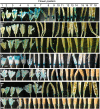A novel approach to dissect the abscission process in Arabidopsis
- PMID: 22992509
- PMCID: PMC3490599
- DOI: 10.1104/pp.112.205955
A novel approach to dissect the abscission process in Arabidopsis
Abstract
Abscission is the consequence of a specialized layer of cells undergoing a complex series of molecular and biochemical events. Analysis of the specific molecular changes associated with abscission is hampered by contamination from neighboring nonseparating tissues. Moreover, studies of abscission frequently involve the examination of events that take place in isolated segments of tissue exposed to nonphysiological concentrations of ethylene or indole-3-acetic acid for protracted periods (more than 24 h) of time. To resolve these problems, we have adopted the use of a transgenic line of Arabidopsis (Arabidopsis thaliana) where the promoter of an abscission-specific polygalacturonase gene (At2g41850/ARABIDOPSIS DEHISCENCE ZONE POLYGALACTURONASE2) has been fused to a green fluorescent protein reporter. RNA was extracted from green fluorescent protein-tagged cells, released from abscising floral organs, and used to generate a complementary DNA library. This library was used to probe a microarray, and a population of abscission-related transcripts was studied in detail. Seven novel abscission-related genes were identified, four of which encode proteins of unknown function. Reverse transcription-polymerase chain reaction analyses and promoter fusions to the β-glucuronidase reporter gene confirmed the expression of these genes in the abscission zone and revealed other places of expression during seedling development. Three of these genes were studied further by crossing reporter lines to the abscission mutants inflorescence deficient in abscission (ida) and blade-on-petiole1 (bop1)/bop2 and an IDA-overexpressing line. Phenotypic analysis of an At3g14380 transfer DNA insertion line indicates that this gene plays a functional role in floral organ shedding. This strategy has enabled us to uncover new genes involved in abscission, and their possible contribution to the process is discussed.
Figures








Similar articles
-
The BLADE-ON-PETIOLE genes are essential for abscission zone formation in Arabidopsis.Development. 2008 Apr;135(8):1537-46. doi: 10.1242/dev.012807. Epub 2008 Mar 13. Development. 2008. PMID: 18339677
-
The manipulation of auxin in the abscission zone cells of Arabidopsis flowers reveals that indoleacetic acid signaling is a prerequisite for organ shedding.Plant Physiol. 2013 May;162(1):96-106. doi: 10.1104/pp.113.216234. Epub 2013 Mar 18. Plant Physiol. 2013. PMID: 23509178 Free PMC article.
-
Ethylene-dependent and -independent pathways controlling floral abscission are revealed to converge using promoter::reporter gene constructs in the ida abscission mutant.J Exp Bot. 2006;57(14):3627-37. doi: 10.1093/jxb/erl130. Epub 2006 Sep 21. J Exp Bot. 2006. PMID: 16990374
-
IDA: a peptide ligand regulating cell separation processes in Arabidopsis.J Exp Bot. 2013 Dec;64(17):5253-61. doi: 10.1093/jxb/ert338. Epub 2013 Oct 22. J Exp Bot. 2013. PMID: 24151306 Review.
-
Four shades of detachment: regulation of floral organ abscission.Plant Signal Behav. 2014;9(11):e976154. doi: 10.4161/15592324.2014.976154. Plant Signal Behav. 2014. PMID: 25482787 Free PMC article. Review.
Cited by
-
Expression Kinetics of Regulatory Genes Involved in the Vesicle Trafficking Processes Operating in Tomato Flower Abscission Zone Cells during Pedicel Abscission.Life (Basel). 2020 Nov 6;10(11):273. doi: 10.3390/life10110273. Life (Basel). 2020. PMID: 33172002 Free PMC article.
-
Multiple tissue-specific expression of rice seed-shattering gene SH4 regulated by its promoter pSH4.Rice (N Y). 2015 Feb 14;8:12. doi: 10.1186/s12284-015-0047-4. eCollection 2015. Rice (N Y). 2015. PMID: 25844117 Free PMC article.
-
The Transcription Factor AtDOF4.7 Is Involved in Ethylene- and IDA-Mediated Organ Abscission in Arabidopsis.Front Plant Sci. 2016 Jun 17;7:863. doi: 10.3389/fpls.2016.00863. eCollection 2016. Front Plant Sci. 2016. PMID: 27379143 Free PMC article.
-
Homogalacturonan-modifying enzymes: structure, expression, and roles in plants.J Exp Bot. 2014 Oct;65(18):5125-60. doi: 10.1093/jxb/eru272. Epub 2014 Jul 23. J Exp Bot. 2014. PMID: 25056773 Free PMC article. Review.
-
Molecular understanding of postharvest flower opening and senescence.Mol Hortic. 2021 Aug 24;1(1):7. doi: 10.1186/s43897-021-00015-8. Mol Hortic. 2021. PMID: 37789453 Free PMC article. Review.
References
-
- Adamczyk BJ, Lehti-Shiu MD, Fernandez DE. (2007) The MADS domain factors AGL15 and AGL18 act redundantly as repressors of the floral transition in Arabidopsis. Plant J 50: 1007–1019 - PubMed
-
- Alonso JM, Stepanova AN, Leisse TJ, Kim CJ, Chen H, Shinn P, Stevenson DK, Zimmerman J, Barajas P, Cheuk R, et al. (2003) Genome-wide insertional mutagenesis of Arabidopsis thaliana. Science 301: 653–657 - PubMed
-
- Belfield EJ, Ruperti B, Roberts JA, McQueen-Mason S. (2005) Changes in expansin activity and gene expression during ethylene-promoted leaflet abscission in Sambucus nigra. J Exp Bot 56: 817–823 - PubMed
Publication types
MeSH terms
Substances
Grants and funding
LinkOut - more resources
Full Text Sources
Molecular Biology Databases

